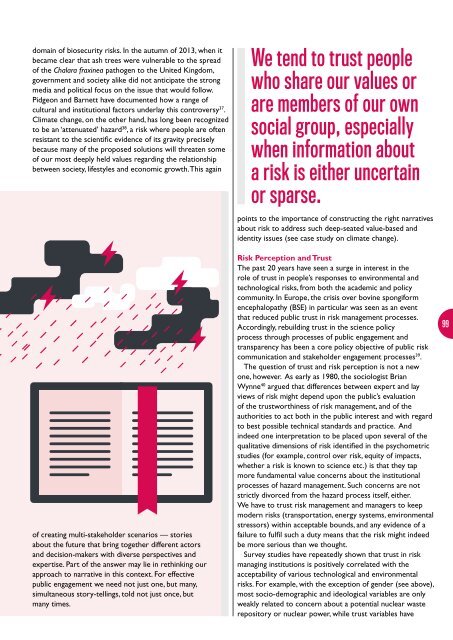14-1190b-innovation-managing-risk-evidence
14-1190b-innovation-managing-risk-evidence
14-1190b-innovation-managing-risk-evidence
You also want an ePaper? Increase the reach of your titles
YUMPU automatically turns print PDFs into web optimized ePapers that Google loves.
domain of biosecurity <strong>risk</strong>s. In the autumn of 2013, when it<br />
became clear that ash trees were vulnerable to the spread<br />
of the Chalara fraxinea pathogen to the United Kingdom,<br />
government and society alike did not anticipate the strong<br />
media and political focus on the issue that would follow.<br />
Pidgeon and Barnett have documented how a range of<br />
cultural and institutional factors underlay this controversy 37 .<br />
Climate change, on the other hand, has long been recognized<br />
to be an ‘attenuated’ hazard 38 , a <strong>risk</strong> where people are often<br />
resistant to the scientific <strong>evidence</strong> of its gravity precisely<br />
because many of the proposed solutions will threaten some<br />
of our most deeply held values regarding the relationship<br />
between society, lifestyles and economic growth. This again<br />
of creating multi-stakeholder scenarios — stories<br />
about the future that bring together different actors<br />
and decision-makers with diverse perspectives and<br />
expertise. Part of the answer may lie in rethinking our<br />
approach to narrative in this context. For effective<br />
public engagement we need not just one, but many,<br />
simultaneous story-tellings, told not just once, but<br />
many times.<br />
We tend to trust people<br />
who share our values or<br />
are members of our own<br />
social group, especially<br />
when information about<br />
a <strong>risk</strong> is either uncertain<br />
or sparse.<br />
points to the importance of constructing the right narratives<br />
about <strong>risk</strong> to address such deep-seated value-based and<br />
identity issues (see case study on climate change).<br />
Risk Perception and Trust<br />
The past 20 years have seen a surge in interest in the<br />
role of trust in people’s responses to environmental and<br />
technological <strong>risk</strong>s, from both the academic and policy<br />
community. In Europe, the crisis over bovine spongiform<br />
encephalopathy (BSE) in particular was seen as an event<br />
that reduced public trust in <strong>risk</strong> management processes.<br />
Accordingly, rebuilding trust in the science policy<br />
process through processes of public engagement and<br />
transparency has been a core policy objective of public <strong>risk</strong><br />
communication and stakeholder engagement processes 39 .<br />
The question of trust and <strong>risk</strong> perception is not a new<br />
one, however. As early as 1980, the sociologist Brian<br />
Wynne 40 argued that differences between expert and lay<br />
views of <strong>risk</strong> might depend upon the public’s evaluation<br />
of the trustworthiness of <strong>risk</strong> management, and of the<br />
authorities to act both in the public interest and with regard<br />
to best possible technical standards and practice. And<br />
indeed one interpretation to be placed upon several of the<br />
qualitative dimensions of <strong>risk</strong> identified in the psychometric<br />
studies (for example, control over <strong>risk</strong>, equity of impacts,<br />
whether a <strong>risk</strong> is known to science etc.) is that they tap<br />
more fundamental value concerns about the institutional<br />
processes of hazard management. Such concerns are not<br />
strictly divorced from the hazard process itself, either.<br />
We have to trust <strong>risk</strong> management and managers to keep<br />
modern <strong>risk</strong>s (transportation, energy systems, environmental<br />
stressors) within acceptable bounds, and any <strong>evidence</strong> of a<br />
failure to fulfil such a duty means that the <strong>risk</strong> might indeed<br />
be more serious than we thought.<br />
Survey studies have repeatedly shown that trust in <strong>risk</strong><br />
<strong>managing</strong> institutions is positively correlated with the<br />
acceptability of various technological and environmental<br />
<strong>risk</strong>s. For example, with the exception of gender (see above),<br />
most socio-demographic and ideological variables are only<br />
weakly related to concern about a potential nuclear waste<br />
repository or nuclear power, while trust variables have<br />
99


